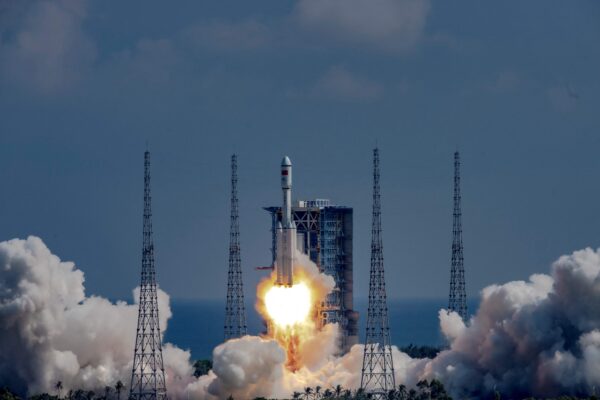China and US Battle for the Moon and Stars
Distressed Patriotic Flag Unisex T-Shirt - Celebrate Comfort and Country $11.29 USD Get it here>>

Commentary
The terrestrial arms race has morphed into Space Wars as China and the United States race to control the moon, satellite orbits, and Mars.
“[China] is the only country with both the intent to reshape the international order and increasingly the economic, diplomatic, military and technological power to achieve that objective,” Lt. Gen. Nina Armagno, director of staff of the U.S. Space Force, said in a presentation at the Australian Strategic Policy Institute (ASPI) on Nov. 27, 2022.
Bill Nelson, the administrator of the National Aeronautics and Space Administration (NASA), warned that the Chinese regime could claim the resource-rich areas of the moon. In 2020, China already released a plan for a $10 trillion Earth-moon economic zone. The CCP is clearly planning to cash in on space exploration for economic gain.
There is also a danger of the Chinese Communist Party (CCP) staking out the most desirable orbits and radio frequencies. Furthermore, in a Jan. 1 interview, Nelson told Politico that he is concerned that China could set up scientific research operations on desirable tracts of moon land and claim sovereignty over it. Last year, the CCP set up an Earth-orbiting space station and conducted several missions where they orbited the moon and retrieved samples. In 2025, Beijing plans to establish an autonomous lunar research station near the moon’s south pole.
In addition to extracting economic profits, the CCP has strategic reasons for wanting to win the space race. Armagno told ASPI that she is concerned that the Chinese will catch up and surpass the United States and that they could militarize space. According to the general, the CCP is developing military space technology in the areas of satellite communications and reusable spacecraft, such as China’s Long March 8R, Long March 9, and suborbital and orbital spacecraft.

During a Dec. 20, 2022, China Central Television broadcast, Chairman of China Aerospace Science and Technology Corporation (CASC) Wu Yansheng outlined the country’s space goals, including concepts for a crewed lunar landing, creating space-transportation infrastructure, and on-orbit servicing as well as Beijing’s vision for space governance, space law, and space domain awareness.
China’s overall moon and space strategy focuses on developing domestic capabilities rather than depending on international cooperation. To this end, CASC completed and launched the Tiangong space station in 2022. Over the next 10 to 15 years, Beijing plans to complete three Chang’e robotic landing missions and establish the International Lunar Research Station (ILRS). One of the unmanned missions to Mars is supposed to return with samples.
While Beijing is seeking partners for the IRLS, the United States will not be invited. And the IRLS will exist parallel to the U.S. Artemis program.
By the decade’s end, Beijing plans to land taikonauts (Chinese astronauts) on the moon. China is considering using nuclear propulsion rather than a rocket engine to decrease the time to Mars and back from 900 days to 500. All of this is part of Chinese leader Xi Jinping’s strategic plan to build a strong space nation.
Xi’s vision is for China to be the world’s No. 1 aerospace power by 2030 and to become a fully comprehensive space power by 2045. The realization of this vision will require efficient, low-cost space transportation, a focus on exploration, and expansion of national civil space infrastructure, which would combine telecommunications, navigation, and positioning constellations with global coverage.
Although colonizing the moon and Mars is still a long way into the future, China and Russia already have killer satellites that can destroy U.S. satellites and wreak havoc among ground forces.

To counter the CCP’s space ambitions, former President Donald Trump inaugurated the U.S. Space Force in 2019 as a branch of the U.S. military under the Air Force with a relationship similar to the one between the Marine Corps and the Navy. On Dec. 14, 2022, the U.S. Space Force activated its first overseas command, U.S. Space Force Korea (SPACEFOR-KOR), whose mission is to oversee space operations in the U.S. Indo-Pacific Command area.
Meanwhile, NASA’s Artemis program is in full swing and tasked with establishing a sustainable human presence on the moon in preparation for a manned mission to Mars. NASA recently completed the 26-day Artemis I mission photographing the moon.
The United States is now locked in a space race with China like it was with the Soviets 60 years ago. The USSR and the United States were competing first to put a man in space and later to put a man on the moon for reputation and prestige.
The stakes with China are direr, though, as it’s not about bragging rights but about claiming dominion over the moon and Mars. Domination in space may be the deciding factor in future wars, as modern armies depend on satellites for communication, navigation, and guiding missiles.
The new Defense Appropriations Bill for 2023 includes $26.3 billion in funding for the Space Force. Additionally, the U.S. chip ban has been expanded to cover space technology. In August last year, seven Chinese aerospace companies were added to the blacklist. Under Secretary of Commerce for Industry and Security Alan Estevez said in an Aug. 23 statement, “U.S. technologies that support space and aerospace activities should not be used to support the PRC’s [People’s Republic of China] military modernization.”
Views expressed in this article are the opinions of the author and do not necessarily reflect the views of The Epoch Times.





